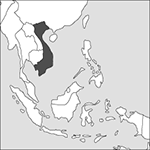
Source: MAPS IN MINUTES™ © RH Publications (1997)
Capital:
Hanoi
Area:
331,210 sq km (127,881 sq miles)
Population:
8,628,000 (2005)
Currency:
1 dong = 10 hao = 100 xu
Religions:
Buddhist 9.3%; Roman Catholic 6.7%; Hoa Hao 1.5%
Ethnic Groups:
Vietnamese (Kinh) 85.7%; Tai 1.9%; Thai 1.8%
Languages:
Vietnamese (official); English; minority languages
International Organizations:
UN; ASEAN; Colombo Plan; Non-Aligned Movement; WTO
A country in south-east Asia, shaped like an ‘S’, bordering on China on the north and Laos and Cambodia on the west, and having long east and south coasts on the South China Sea.
Physical
In the north of Vietnam the Red and Black rivers flow from forested mountains across wet lowlands spread with paddy fields. The south is even wetter, with rice being cultivated down the coastal strip and in the Mekong delta. Rubber and other crops are grown in areas where the ground rises to the central highlands.
Economy
Vietnam had a centrally planned communist economy until 1986, when it adopted free-market reforms; state-owned enterprises now contribute about two-fifths of GDP. Industry has been promoted in recent years and the agricultural sector has correspondingly declined in importance; however, it still employs almost half the workforce. Seafood, rice, and coffee are exported; other agricultural products include rubber, tea, pepper, and soya beans. Industrial exports include clothes, shoes, electronics, oil, wooden products, and machinery. There are large reserves of oil, coal, iron ore, and other minerals.
History
In 1802 the two states of Annam and Tonkin were reunited by the Annamese general Nguyen Anh, who became emperor Gia-Long. Gia-Long was given French assistance and French influence increased in the 19th century. By 1883 Vietnam was part of French Indo-China, although a weak monarchy was allowed to remain. In World War II the Japanese occupied it but allowed Vichy France to administer it until March 1945. In September 1945 Ho Chi Minh declared its independence, but this was followed by French reoccupation and the French Indo-Chinese War. The Geneva Conference (1954), convened to seek a solution to the Indochina conflict, partitioned Vietnam along the 17th parallel, leaving a communist Democratic Republic with its capital at Hanoi in the north, and, after the deposition of the former emperor Bao Dai in 1955, a non-communist republic with its capital at Saigon in the south. Ho Chi Minh, the North Vietnamese leader, remained committed to a united communist country, and by the time the South Vietnamese President Ngo Dinh Diem was overthrown by the military in 1963, communist insurgents of the Vietcong were already active in the south. Communist attempts to take advantage of the political confusion in the south were accelerated by the infusion of massive US military assistance, and in the late 1960s and early 1970s, the Vietnam War raged throughout the area, with the heavy use of US airpower failing to crush growing communist strength. Domestic pressures helped accelerate a US withdrawal and, after abortive peace negotiations, the North Vietnamese and their Vietcong allies finally took Saigon in April 1975; a united Socialist Republic of Vietnam was proclaimed in the following year. Despite the severe damage done to the economy, Vietnam adopted an aggressively pro-Soviet foreign policy, dominating Laos, invading Cambodia to overthrow the Khmer Rouge regime (1975–79), and suffering heavily in a brief border war with China (1979). In 1989, Vietnamese troops withdrew from Cambodia. Attempts to reorder society in the south of the country produced a flood of refugees, damaging Vietnam’s international standing and increasing its dependence on the Soviet Union. Many of these refugees were from the Chinese minority; known as the ‘Boat People,’ they fled Vietnam in small boats on the South China Sea. With the disintegration of the Soviet Union in 1991, Vietnam was prompted to normalize relations with China and the USA. A new constitution was adopted in 1992, incorporating major economic and political reforms. However, the Communist Party of Vietnam retained its position as the sole political party. Relations with the USA continued to improve during 1993–94, with joint investigations taking place into the whereabouts of US servicemen missing in action during the Vietnam War. Economic links were forged with the USA and other countries (e.g. Japan and Britain), notably to exploit oil and natural gas fields in the country’s territorial waters. Vetted non-Communist candidates were allowed to stand in legislative elections from 1997. In 2001, following popular demonstrations, the Party leadership acted to curb corruption and galvanize economic development. Vietnam joined the World Trade Organization in 2007, the same year that its president made the first official visit to the USA since the war. Domestically the government continued to suppress opposition and tackle corruption, particularly in state-run companies. In 2008 it finally resolved the land border dispute with China that had caused conflict thirty years earlier but relations have remained tense over disputed areas in the South China Sea. This problem was exacerbated from 2015 by China's attempt to assert control in the Paracel and Spratly Islands.
- siderostat
- side-scan sonar
- side stream
- sidewall corer
- sidewinder
- Sidgwick, Henry (1838–1900)
- Sidgwick, Nevil Vincent
- Siding Spring Observatory
- Sidufjall
- Siegbahn, Kai Manne Börje
- Siegbahn, Karl Manne Georg
- Siegel, Sidney (1916–61)
- Siegel–Tukey test
- Siegennian
- Siegfried Line
- Siemens
- siemens
- Siemens, Ernst Werner von
- Siemens, Sir William
- siemens(symbol: S)
- Siemen’s electrodynamometer
- Sierpinski triangle
- Sierra Leone
- sieve
- sieve benchmark